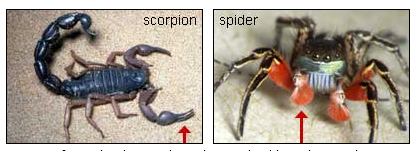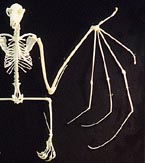Developmental changes have likely been involved in important morphological changes — like the evolution of novel and complex structures.
Here are a few of the sorts of developmental changes that may have been important:
- Module duplication and adaptation
A module refers to a unit that can be duplicated and further adapted. For example, arthropods have various numbers of body segments. Segment duplication and loss is a developmental change that probably occurred many times in the evolution of this clade. The graphic below shows a hypothetical example of module duplication and adaptation.

- Individualization
This is the modification of a particular module, usually when there is selection for a specialized function.
One set of scorpions’ appendages has evolved into pincers whereas the same appendage in many spiders has evolved into colorful pompoms used in mating rituals. Scorpion image courtesy of the California Academy of Sciences; Spider image courtesy of Michael Hedin, San Diego State University. - Heterochrony
Heterochrony is a change in the timing of developmental events. For example, a change in timing might slow down the development of the body, but not alter the maturation of the reproductive system. This change yields an adult organism with a form similar to the ancestral juvenile form.
Larval salamander image courtesy of Jeff LeClere; Tiger salamander image courtesy of Greg Sievert; Axolotl image courtesy of Barbara Shardy. Salamanders go through a larval stage in which they have feathery, external gills (left). Most salamanders lose these gills when they metamorphose into adults (center). Because of heterochrony, axolotls now retain the juvenile external gills as fully reproductive adults (right).
- Allometric growth

Image courtesy of Ben Waggoner Allometric growth is a change in the rate of growth of a dimension or feature relative to other features. For example, we can describe some of the evolutionary changes that produced bats in terms of allometry. Bat wings are basically paws with really long fingers and skin stretched between them. In order for these wings to evolve, the rate of growth of finger bones must have increased relative to the growth of the rest of the bat’s body — or perhaps the rate of growth of the rest of the body decreased relative to the fingers. Either way, it is allometry.
Read more about how development factored into the history of evolutionary thought.
Learn more about evolution and development in context: Why the eye?, a case study.
Teach your students about development:
- Mealworm metamorphosis, a classroom activity for grades 3-5.
- From butterflies to humans, a lecture for grades 9-12.
Find additional lessons, activities, videos, and articles that focus on development.
